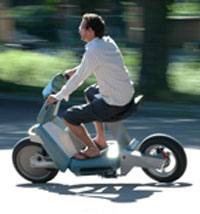High-tech hydrogen scooter designed to sell clean technology

The Fhybrid scooter can be hydrogen-powered.
The scooter has an electric in-wheel motor that derives its power from a (Li-)ion battery. This battery (primarily when the scooter is stationary) is charged by a compact fuel-cell system, which derives its energy from hydrogen (from a tank) and oxygen (from the air). The battery moreover stores up energy when the scooter brakes. Depending on the amount of traffic, this so-called regenerating braking system reduces the hydrogen consumption by 10-20 percent. To use the energy generated during breaking optimally, the scooter is front-wheel driven.
Apart from being environmentally friendly, the Fhybrid performs better than regular petrol powered scooters during test drives. The Fhybrid has a top speed of 65 km/ph, accelerates faster than regular scooters and can travel approximately 200 km on a full tank of hydrogen. An additional feature is the parking assistant. The electric engine can be very precisely controlled when travelling at low speeds, enabling the driver to park backwards or forwards without having to push the entire scooter into place.
The Fhybrid is designed to be hydrogen-powered, but for now the prototype is powered by batteries, with the help of a fuel-cell simulator that was specially designed for this project. “A special course and various permits are required to build a hydrogen-powered engine. It wasn't possible to achieve this during the time period of my graduation project”, Crijn Bouman explained. “The faculty is now trying to assemble all the necessary means to fully develop the hydrogen-powered scooter.”
The Fhybrid's complete drive system and energy management system were built by Epyon, a TU Delft spin-off company, of which Bouman is one of the founders, and in partnership with the Delft Design Institute.
Media Contact
More Information:
http://www.tudelft.nlAll latest news from the category: Transportation and Logistics
This field deals with all spatial and time-related activities involved in bridging the gap between goods and people, including their restructuring. This begins with the supplier and follows each stage of the operational value chain to product delivery and concludes with product disposal and recycling.
innovations-report provides informative reports and articles on such topics as traffic telematics, toll collection, traffic management systems, route planning, high-speed rail (Transrapid), traffic infrastructures, air safety, transport technologies, transport logistics, production logistics and mobility.
Newest articles

Innovative 3D printed scaffolds offer new hope for bone healing
Researchers at the Institute for Bioengineering of Catalonia have developed novel 3D printed PLA-CaP scaffolds that promote blood vessel formation, ensuring better healing and regeneration of bone tissue. Bone is…

The surprising role of gut infection in Alzheimer’s disease
ASU- and Banner Alzheimer’s Institute-led study implicates link between a common virus and the disease, which travels from the gut to the brain and may be a target for antiviral…

Molecular gardening: New enzymes discovered for protein modification pruning
How deubiquitinases USP53 and USP54 cleave long polyubiquitin chains and how the former is linked to liver disease in children. Deubiquitinases (DUBs) are enzymes used by cells to trim protein…



